- Home
- Peter F. Hamilton
The Dreaming Page 5
The Dreaming Read online
Page 5
The Admiral wore a black uniform of old-fashioned cloth, stylishly cut. It suited him perfectly, emphasizing broad shoulders and a lean torso, the classic authority figure. He was tall with an olive skin and a handsome face; Troblum recognized some of his father’s characteristics, the blunt jaw and jet black hair, but his mother’s finer features were there also, a nose that was almost dainty and pale friendly eyes.
“Admiral!” Troblum exclaimed.
“Pleased to meet you,” Kazimir Burnelli extended a hand.
It took Troblum a moment before he realized what to do, and put out his own hand to shake—suddenly very pleased his toga suit had a cooling web and he was no longer sweating. The social formality file his u-shadow had pushed into his exovision was abruptly withdrawn.
“I’ll be representing ANA:Governance for this presentation,” Kazimir said. Troblum had guessed as much. Kazimir Burnelli was the essential human link in the chain between ANA:Governance and the ships of the Navy deterrent fleet, a position of trust and responsibility he’d held for over eight hundred years. Something in the way he carried himself was indicative of all those centuries he’d lived, an aura of weariness that anyone in his presence couldn’t help be aware of.
There were so many things Troblum was desperate to ask, starting with: Have you stayed in your body so long because your father’s life was so short? And possibly: Can you get me access to your grandfather? But instead he meekly said, “Thank you for coming, Admiral.” Another privacy shield came on around the chamber, and the net confirmed they were grade-one secure.
“So what have you got for us?” the Admiral asked.
“A theory on the Dyson Pair generators,” Troblum said. He activated the chamber’s web node so the others could share the data and projections in his files, and began to explain.
The Dyson Pair were stars three lightyears apart that were confined within giant force fields. The barriers had been established in AD 1200 by the Anomine for good reason. The Prime aliens who had already spread from their homeworld around Alpha to Beta were pathologically hostile to all biological life except their own. The Starflyer was one of them that had escaped imprisonment, and it had manipulated the Commonwealth into opening the force field around Dyson Alpha, resulting in a war which had killed in excess of fifty million humans. Eventually, the force field had been reactivated by Ozzie and Mark Vernon, ending the War, but it had been a shockingly close call. The Navy had kept an unbroken watch on the stars ever since.
Centuries later, when the Raiel invited the Commonwealth to join the Void observation project at Centurion Station, human scientists had been startled by the similarity of the planet-sized defence systems deployed throughout the Wall stars and the generators that produced the Dyson Pair force fields.
Until now, Troblum said, everyone assumed the Anomine had a technology base equal to the Raiel. He disputed that. His analysis of the Dyson Pair generators showed they were almost identical in concept to the Centurion Station DF machines.
“Which proves the point, surely?” Yehudi said.
“Quite the opposite,” Troblum replied smoothly.
The Anomine homeworld had been visited several times by the Navy exploration division. As a species they had divided two millennia ago; with the most technologically advanced group elevating to post-physical sentience, while the remainder retroevolved to a simple pastoral culture. Although they had developed wormholes and sent exploration ships ranging across the galaxy, they had only ever settled a dozen or so nearby star systems, none of which had massive astroengineering facilities. The remaining pastoral societies had no knowledge of the Dyson Pair generators, and the post-physicals had long since withdrawn from contact with their distant cousins. An extensive search of the sector by successive Navy ships had failed to locate the assembly structure for the Dyson Pair generators. Until now, human astro-archaeologists had assumed the abandoned machinery had decayed away into the vacuum, or was simply lost.
Given the colossal scale involved, Troblum said, neither was truly believable. First off, however sophisticated they were, it would have taken the Anomine at least a century to build such a generator starting from scratch, let alone two of them—look how long it was taking Highers to construct Air, and that was with near unlimited EMAs. Secondly, the generators were needed quickly. The Prime aliens of Dyson Alpha were already building slower than light starships, which was why the Anomine sealed them in. If there had been a century gap while the Anomine beavered away at construction, the Primes would have expanded out to every star within a fifty lightyear radius before the generators were finished.
“The obvious conclusion,” Troblum said, “is that the Anomine simply appropriated existing Raiel systems from the Wall. All they would need for that would be a scaled-up wormhole generator to transport them to the Dyson Pair, and we know they already possessed the basic technology. What I would like is for the Navy to start a detailed search of interstellar space around the Dyson Pair. The Anomine wormhole drive or drives could conceivably still be there. Especially if it was a ‘one shot’ device.” He gave the Admiral an expectant look.
Kazimir Burnelli paused as the last of Troblum’s files closed. “The Primes built the largest wormhole ever known in order to invade the Commonwealth across five hundred lightyears,” he said.
“It was called Hell’s Gateway,” Troblum said automatically.
“You do know your history. Good. Then you should also know it was only a couple of kilometres in diameter. Hardly enough to transport the barrier generators.”
“Yes, but I’m talking about a completely new manifestation of wormhole drive technology. A wormhole that doesn’t need a correspondingly large generator: you simply project the exotic matter effect to the size required.”
“I’ve never heard of anything like that.”
“It can be achieved easily within our understanding of wormhole theory, Admiral.”
“Easily?” Kazimir Burnelli turned to Mykala. “Captain?”
“I suppose it may be possible,” Mykala said. “I’d need to re-examine exotic matter theory before I could say one way or another.”
“I’m already working on a method,” Troblum blurted.
“Any success?” Mykala queried.
Troblum suspected she was being derisive, but lacked the skill to interpret her tone. “I’m progressing, yes. There’s certainly no theoretical block to diameter. It’s all down to the amount of energy available.”
“To ship a Dyson barrier generator halfway across the galaxy you’d need a nova,” Mykala said.
Now Troblum was sure she was mocking him. “It needs nothing like that much energy,” he said. “In any case, if they built the generators on or near their home star they would still have needed a transport system, wouldn’t they? If they built them in situ, which is very doubtful, where is the construction site? We’d have found something that big by now. Those generators were moved from wherever the Raiel had originally installed them.”
“Unless it was produced by their post-physicals,” she said. “Who knows what abilities they have or had.”
“Sorry, I’m going to have to go with Troblum on that one,” Eoin said. “We know the Anomine didn’t elevate to post-physical status until after the Dyson barriers were established, that’s approximately a hundred and fifty years later.”
“Exactly,” Troblum said triumphantly. “They had to be using a level of technology effectively equal to ours. Somewhere out there in interstellar space is an abandoned drive system capable of moving objects the size of planets. We need to find it, Admiral. I’ve already compiled a search methodology using current Navy exploration craft which I’d like—”
“Let me just stop you there,” Kazimir Burnelli said. “Troblum, what you’ve given us so far is a very convincing hypothesis. So much so that I’m going to immediately forward your data to a senior department review committee. If they give me a positive verdict you and I will discuss the Navy’s investigation options. And beli
eve me, for this day and age, that’s being fast-tracked, okay?”
“But you can sanction the exploration division to begin the search right away, you have that authority.”
“I do, yes; but it don’t exercise it without good reason. What you’ve shown us is more than sufficient to start a serious appraisal. We will follow due process. Then if you’re right—”
“Of course I’m fucking right,” Troblum snapped. He knew in a remote fashion he was acting inappropriately, but his goal was so close. He’d assumed the Admiral’s unexpected appearance today meant the search could begin right away. “I don’t have the EMAs for that many starships myself, that’s why the Navy has to be involved.”
“There would never be an opportunity for an individual to perform a search,” Kazimir replied lightly. “Space around the Dyson Pair remains restricted. This is a Navy project.”
“Yes Admiral,” Troblum mumbled. “I understand.” Which he did. But that didn’t quell the resentment at the bureaucracy involved.
“I notice you haven’t included your results on this ‘one shot’ wormhole drive idea,” Mykala said. “That’s a big hole in the proposal.”
“It’s at an early stage,” Troblum said, which wasn’t quite true. He’d held back on his project precisely because he was so near to success. It was going to be the clinching argument if the presentation hadn’t gone well. Which in a way it hadn’t. But… “I hope to be giving you some positive results soon.”
“That I will be very interested in,” Kazimir said, finally producing a smile that lifted centuries away from him. “Thank you for bringing this to us. And I do genuinely appreciate the effort involved.”
“It’s what I do,” Troblum said gruffly. He kept silent as the shielding switched off, and the others left the chamber. What he wanted to shout after the Admiral was: Your mother made her decisions without any committee to hold her hand, and as for what your grandfather would say about getting a consensus… Instead he let out a disgruntled breath as he sealed the files back into his storage lacuna. Meeting an idol was always such a risk, so few of them ever really matched up to their own legend.
***
The Delivery Man was woken by his youngest daughter just as a chilly dawn light was rising outside. Little Rosa had once again decided that five hours’ sleep was quite sufficient for her, now she was sitting up in her cot wailing for attention. And milk. Beside him, Lizzie was just starting to stir out of a deep sleep. Before she could wake, he swung himself out of bed and hurried along the landing to the nursery. If he wasn’t quick enough Tilly and Elsie would be woken up, then nobody would get any peace.
The paediatric housebot floated through the nursery door after him, a simple ovoid just over a metre high. It extruded Rosa’s milk bulb through its neutral grey skin. Both he and his wife Lizzie hated the idea of a machine, even one as sophisticated as the housebot, caring for the child, so he settled her on his lap in the big chair at the side of the cot and started feeding her out of the bulb. Rosa smiled adoringly round the nozzle, and squirmed deeper into his embrace. The housebot extended a hose which attached to the outlet patch on her sleepsuit’s nappy, and siphoned away the night’s wee. Rosa waved contentedly at the housebot as it glided out of the nursery.
“Goobi,” she cooed, and resumed drinking.
“Goodbye,” The Delivery Man corrected. At seventeen months, Rosa’s vocabulary was just starting to develop. The biononic organelles in her cells were effectively inactive other than reproducing themselves to supplement her new cells as she grew. Extensive research had shown it was best for a Higher-born human to follow nature’s original development schedule up until about puberty. After that the biononics could be used as intended; one function of which was to modify the body however the host wanted. He still wasn’t sure that was such a good idea, handing teenagers unrestrained power over their own physiology frequently led to some serious self-inflicted blunders. He always remembered the time when he was fourteen and had a terrible crush on a seventeen-year-old girl. He’d tried to improve his genitals. It had taken five hugely embarrassing trips to a biononic procedures doctor to sort out the painful abnormal growths.
When Rosa finished he carried her downstairs. He and Lizzie lived in a classic Georgian townhouse in London’s Holland Park district. It had been restored three hundred years ago using modern techniques to preserve as much of the old fabric as possible without having to resort to stabilizer fields. Lizzie had overseen the interior when they moved in, blending a tasteful variety of furniture and utility systems that dated from the mid-twentieth century right up to up to the twenty-seventh, when ANA’s replication facilities effectively halted human design on Earth. Two spacious sub-basements had been added, giving them an indoor swimming pool and a health spa, along with the tanks and ancillary systems that supplied the culinary cabinet and household replicator.
He took Rosa into the large iron-framed conservatory where her toys were stored in big wicker baskets. February had produced its usual icy morning outside, sending broad patterns of frost worming up the outside of the glass. For now, the only true splash of colour to enjoy in the garden came from the winter flowering cherries on the curving bank behind the frozen fish pond.
When Lizzie came downstairs an hour later she found him and Rosa playing with glow blocks on the conservatory’s heated flagstone floor. Tilly who was seven, and Elsie their five-year-old, followed their mother in, and shouted happily at their younger sister who ran over to them with outstretched arms, babbling away in her own incomprehensible yet excited language. The three girls started to build a tower out of the blocks, the higher they stacked the faster the colours swirled.
He gave Lizzie a quick kiss and ordered the culinary cabinet to produce some breakfast. Lizzie sat at the circular wooden table in their kitchen. An antiquities and culture specialist, she enjoyed the old-fashioned notion of a room specifically for cooking. Even though there was no need for it, she’d had a hefty iron range cooker installed when they moved in ten years ago. During winter its cosy warmth turned the kitchen into the house’s engine room, they always gathered in here as a family. Sometimes she even used the range to cook things which she and the girls made out of ingredients produced by the culinary cabinet. Tilly’s birthday cake had been last.
“Swimming for Tilly this morning,” Lizzie said as she sipped at a big china cup of tea which a housebot delivered to her.
“Again?” he asked.
“She’s getting a lot more confident. It’s their new teacher. He’s very good.”
“Good.” The Delivery Man picked up the croissant on his plate and started tearing it open. “Girls,” he shouted. “Come and sit down please. Bring Rosa.”
“She doesn’t want to come,” Elsie shouted back immediately.
“Don’t make me come and get you.” He avoided looking at Lizzie. “I’m going to be away for a few days.”
“Anything interesting?”
“There’ve been allegations that some companies on Oronsay have got hold of level-three replicator tech,” he said. “I’ll need to run tests on their products.” His current vocation was to monitor the spread of Higher technology across the External Worlds. It was a process which the Externals got very sensitive about, with hardline Protectorate politicians citing it as the first act of cultural colonization, deserving retribution. However, industrialists on the External Worlds were constantly seeking to acquire ever-more sophisticated manufacturing systems to reduce their costs. Radical Highers were equally keen to supply it to them, seeing it precisely as that first important stage for a planet converting to Higher culture. What he had to do, on ANA:Governance’s behalf, was to decide the intent behind supplying replicator systems. If Radical Highers were supporting the companies, then he would subtly disable the systems and collapse the operation. His main problem was making an objective decision; Higher technology inevitably crept out from the Central Worlds, in the same way that the External Worlds were always settling new planets aro
und the edge of their domain. The boundary between Central and External was ambiguous to say the least, with some External Worlds openly welcoming the shift to Higher status. Location was always a huge factor in his decision. Oronsay was over a hundred lightyears out from the Central Worlds, which effectively negated the chance that this was simple technology seepage. If there were replicators there, it was either Radicals pushing them, or a very greedy company.
Lizzie’s eyebrows lifted. “Really? What sort of products?”
“Starship components.”
“Well, that should come in handy out there right now, very profitable I imagine.”
He appreciated her guarded amusement. The last few days had seen a rush of starship company officials to Ellezelin, eager to do deals with the new Cleric Conservator.
The girls scuttled in and settled at the table; Rosa clambered on to the twenty-fifth century suede mushroom that was her tiny-tot seat. It morphed around her, gripping firmly enough to prevent her from falling out, and expanded upwards to bring her level with the table top. She clapped her hands delightedly to be up with her family. Elsie solemnly slid a bowl of honey pops across, which Rosa grabbed. “Don’t spill it today,” Elsie ordered imperiously.
Rosa just gurgled happily at her sister.
“Daddy, will you teleport us to school?” Tilly asked, her voice high and pleading.
“You know I’m not going to,” he told her. “Don’t ask.”
“Oh please, Daddy, please.”
“Yes, Daddy,” Elsie chipped in. “Please t-port. I like it. Lots and lots.”

 A Night Without Stars
A Night Without Stars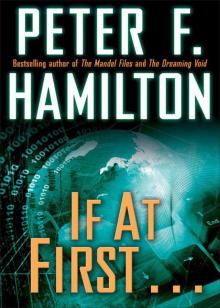 If at First . . .
If at First . . .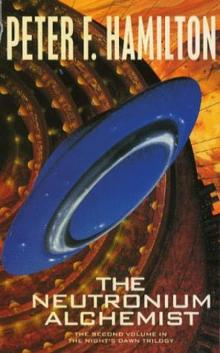 The Neutronium Alchemist
The Neutronium Alchemist Great North Road
Great North Road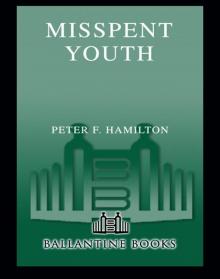 Misspent Youth
Misspent Youth Pandora's Star
Pandora's Star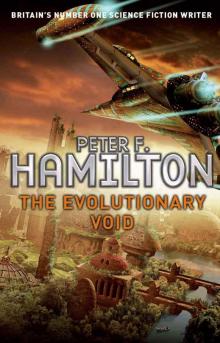 The Evolutionary Void
The Evolutionary Void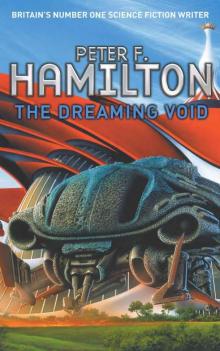 The Dreaming Void
The Dreaming Void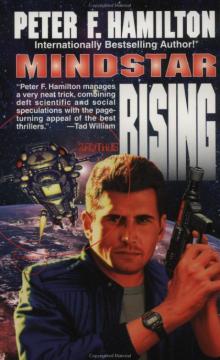 Mindstar Rising
Mindstar Rising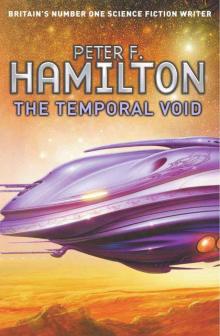 The Temporal Void
The Temporal Void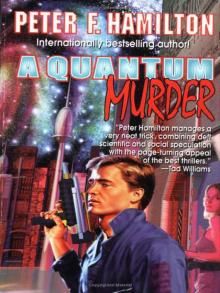 A Quantum Murder
A Quantum Murder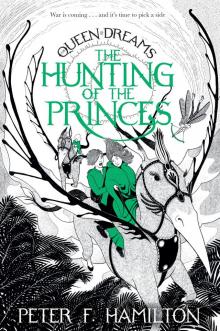 The Hunting of the Princes
The Hunting of the Princes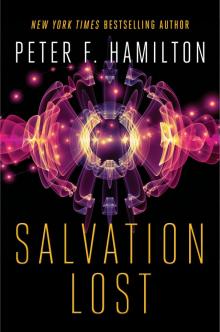 Salvation Lost
Salvation Lost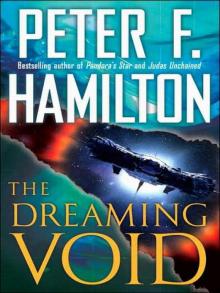 The Dreaming
The Dreaming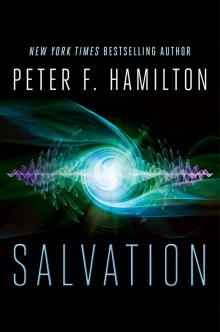 Salvation
Salvation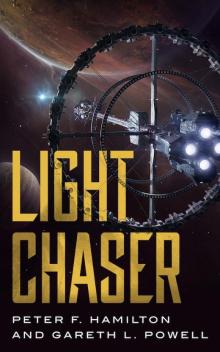 Light Chaser
Light Chaser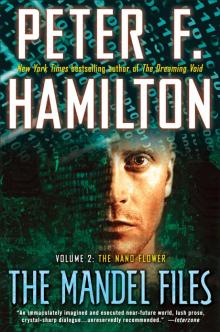 The Mandel Files, Volume 2: The Nano Flower
The Mandel Files, Volume 2: The Nano Flower![The Saints of Salvation [British Ed.] Read online](http://i1.bookreadfree.com/22/the_saints_of_salvation_british_ed__preview.jpg) The Saints of Salvation [British Ed.]
The Saints of Salvation [British Ed.]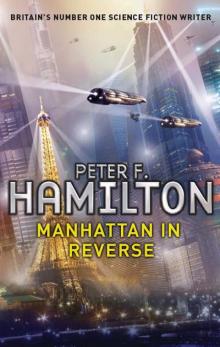 Manhattan in Reverse
Manhattan in Reverse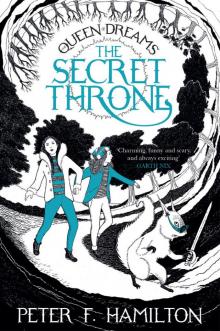 The Secret Throne
The Secret Throne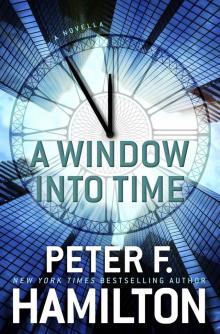 A Window Into Time
A Window Into Time A Second Chance at Eden
A Second Chance at Eden The Nano Flower
The Nano Flower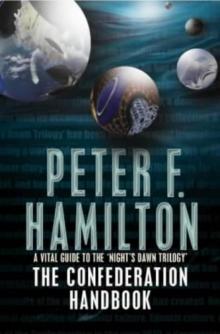 The Confederation Handbook
The Confederation Handbook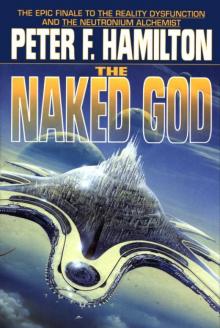 The Naked God
The Naked God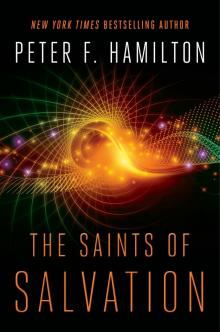 The Saints of Salvation
The Saints of Salvation The Void Trilogy 3-Book Bundle
The Void Trilogy 3-Book Bundle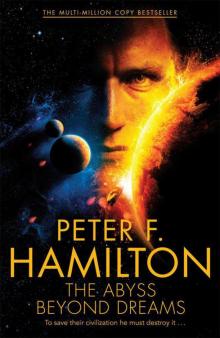 The Abyss Beyond Dreams
The Abyss Beyond Dreams A Voyage Through Air
A Voyage Through Air Judas Unchained
Judas Unchained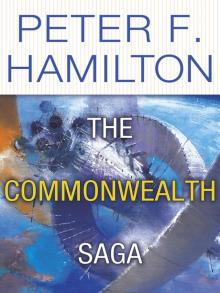 The Commonwealth Saga 2-Book Bundle
The Commonwealth Saga 2-Book Bundle The Naked God - Flight nd-5
The Naked God - Flight nd-5 Night Without Stars (Chronicle of the Fallers Book 2)
Night Without Stars (Chronicle of the Fallers Book 2)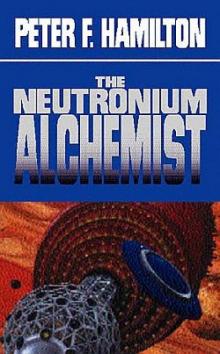 Neutronium Alchemist - Conflict nd-4
Neutronium Alchemist - Conflict nd-4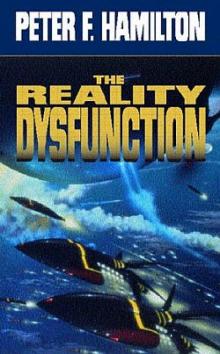 Reality Dysfunction - Expansion nd-2
Reality Dysfunction - Expansion nd-2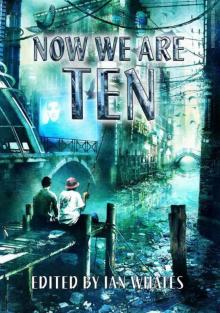 Now We Are Ten: Celebrating the First Ten Years of NewCon Press
Now We Are Ten: Celebrating the First Ten Years of NewCon Press Neutronium Alchemist - Consolidation nd-3
Neutronium Alchemist - Consolidation nd-3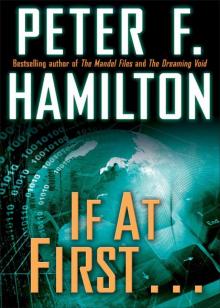 If at First . . . (Short Story)
If at First . . . (Short Story)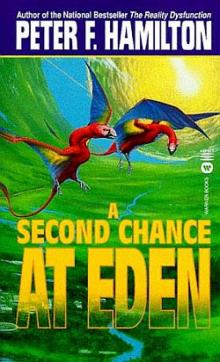 A Second Chance at Eden nd-7
A Second Chance at Eden nd-7 Judas Unchained cs-2
Judas Unchained cs-2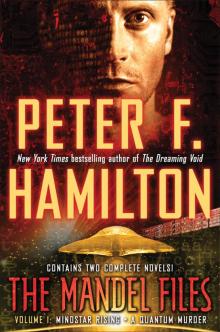 The Mandel Files, Volume 1
The Mandel Files, Volume 1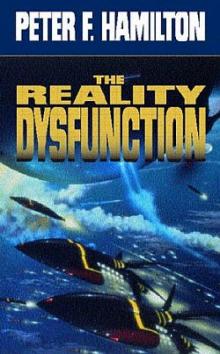 Reality Dysfunction — Emergence nd-1
Reality Dysfunction — Emergence nd-1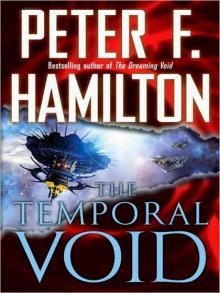 The Temporal Void (ARC)
The Temporal Void (ARC) The Mandel Files
The Mandel Files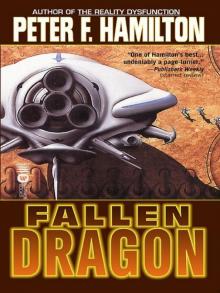 Fallen Fragon
Fallen Fragon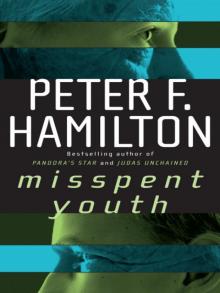 Misspent Youth (commonwealth saga)
Misspent Youth (commonwealth saga)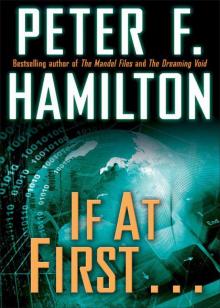 If at First...
If at First... Best of British Science Fiction 2016
Best of British Science Fiction 2016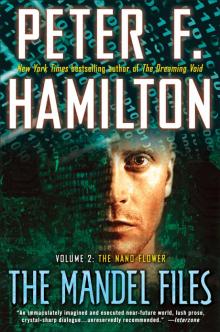 The Mandel Files, Volume 2
The Mandel Files, Volume 2 The Naked God - Faith nd-6
The Naked God - Faith nd-6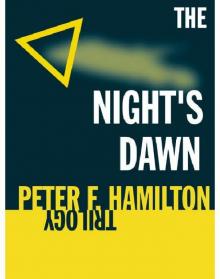 The Night's Dawn Trilogy
The Night's Dawn Trilogy Pandora's Star cs-2
Pandora's Star cs-2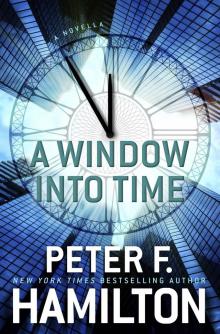 A Window into Time (Novella)
A Window into Time (Novella)